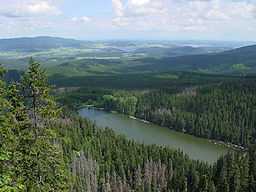Šumava National Park
| Šumava | |
| National Park | |
 Plešné Lake | |
| Country | Czech Republic |
|---|---|
| Regions | Plzeň, South Bohemian |
| Highest point | Plechý |
| - elevation | 1,378 m (4,521 ft) |
| - coordinates | 48°46′16.72″N 13°51′26.21″E / 48.7713111°N 13.8572806°E |
| Lowest point | |
| - location | Otava River at Rejštejn |
| - elevation | 570 m (1,870 ft) |
| - coordinates | 49°08′14″N 13°30′22″E / 49.13722°N 13.50611°E |
| Length | 100 km (62 mi), NW-SE |
| Width | 20 km (12 mi), NE-SW |
| Area | 680.64 km2 (263 sq mi) |
| - CHKO | 996.24 km2 (385 sq mi) |
| Biome | forest (80%) |
| Founded | 1991-03-20 |
| - CHKO | 1963-12-27 |
| Management | Správa NP a CHKO Šumava |
| - location | Vimperk |
 _-_location_map.svg.png) Location of the Šumava NP (darker green) and the Šumava CHKO (lighter green) in the Czech Republic and the adjacent Bayerischer Wald NP in Germany
| |
| Website: www.npsumava.cz | |
Šumava National Park (Czech: Národní park Šumava, usually shortened as NP Šumava) is a National Park in the South Bohemian Regions of the Czech Republic along the border with Germany (where the smaller adjacent Bayerischer Wald National Park lies) and Austria. They protect a little-inhabited area of the mountain range of the same name, the Šumava. Since 1990 it has been the protected Biospherical Reserve of UNESCO. [1]
The Šumava Range is covered by the most extensive forest in Central Europe, whose natural composition was, however, changed and today spruce plantations prevail in most of the area. In many places non-native spruce varieties were planted. These are not well adapted to the harsh local climate and are therefore susceptible to a range of elements, such as strong winds (e.g. in the 1980s or recently at the beginning of 2007) and bark beetle (Ips typographus). Numerous large plateaux with raised peat bogs, glacial lakes and remnants of primeval forests (e.g. Boubín) complete a mosaic of habitats which are little disturbed by human settlements as most of the predominantly German speaking inhabitants were expelled after the World War II and the area became a part of the deserted zone along the Eastern block border. Since the 1970s there has existed a stable population of lynxes.
Originally, a large Landscape Protected Area was declared on 27 December 1963 covering most of the Šumava Range. On 20 March 1991 the most valuable part of the area was declared a National Park with the rest of the Landscape Protected Area serving as its buffer zone.
References
- Rubín, Josef (2003). Národní parky a chráněné krajinné oblasti. Praha: Olympia. ISBN 80-7033-808-3.
- "Správa NP a CHKO Šumava". Retrieved 2007-03-16.
| Wikimedia Commons has media related to Šumava National Park. |
| ||||||